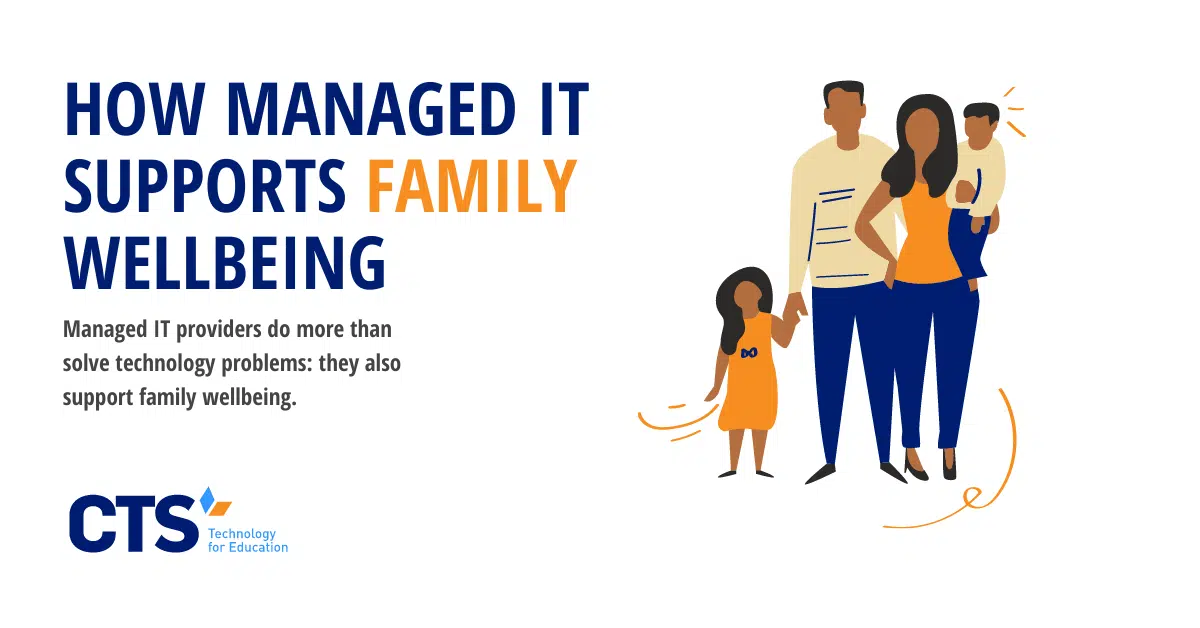COVID-19 fundamentally changed the student-family relationship.
COVID-19 placed the family members of school-aged children in unfamiliar territory. There they were, suddenly, faced with their student, their student’s Chromebook, and a Zoom link: ready to engage in remote learning. Far from passive observers of their students’ learning, families became de facto tutors (or worse, babysitters) during remote learning, ensuring their students logged on to their class Zooms at the appropriate time, completed their schoolwork in a timely fashion, and ultimately salvaged whatever bit of learning was possible during the pandemic. Central to these efforts was the presence (or lack thereof) of managed IT providers, remote support technicians with the skills to guide students through frustrating technology issues. For those families with access to managed IT support services, the transition to and from remote learning was undoubtedly smoother.
Technology is poised to play a more central role than ever in classroom instruction.
As students return to school, however, the preeminence of technology in classroom instruction is unlikely to fade completely. Indeed, many of the benefits of remote learning–online instruction differentiated by content mastery, independent work time, and video conferencing–are likely to remain, at least in small part, elements of teacher practice. During the pandemic, when teachers were unable to directly supervise student work time, online instructional platforms, for example, played a crucial role in monitoring student learning. Differentiating instruction in real-time based on student performance, these platforms effectively “became” the classroom teacher away from the classroom, allowing teachers to remotely monitor student performance.
Students will increasingly take their devices home.
As these and other practices become more common inside the classroom, they’re likely to take on more importance inside students’ homes too. To continue the example with online instructional platforms, it’s not difficult to envision a teacher assigning one or more modules to his students as homework for the next class. Of course, to complete the assignment, students will likely have to take their devices home with them, which in turn places demands on students’ families to monitor their activity.
While some families may have become technical “wizards” during the pandemic, others would likely still struggle to navigate common technical issues without the support of a managed IT provider. Schools that outsource their IT services to a third-party vendor can make use of remote help desks, ticketing systems, and other support services in a way that schools with in-house IT teams simply can’t. The result? Family members who are less frustrated with their students’ technology and kids who can more easily access online instructional content assigned by their teachers.
These benefits similarly extend to students’ summer work. Depending on the school-provider contract, students whose schools outsource their IT services may be able to make use of a help desk or ticketing service during the summer. Many ELA teachers, for example, assign summer reading and writing assignments to their students, requiring them to upload written work to a classroom portal or access excerpts of an online text. Without the support of managed IT providers, families could find themselves troubleshooting their students’ technology issues outside the confines of the academic year. With a managed IT provider, families are at least partially alleviated of this burden.
Managed IT providers are skilled troubleshooters.
It’s not just that managed IT providers shift the burden from families to someone else, however. Third-party vendors also have the added benefit of technical knowledge and troubleshooting support training that family members consistently lack. Of course, there might be the one-off chance of a student’s mom or dad having an IT background, but such examples are few and far between; rather, in most cases, students’ family members are just as lost as the student, forced to devote substantial amounts of time to fix their kid’s technology problem.
Managed IT providers help mitigate these issues by deploying their technical expertise to solve students’ common technology problems. In the end, this training allows the technician to resolve the issue quickly, potentially teach the student how to solve the problem themselves in the future (depending on its complexity), and ultimately enhances family wellbeing by allowing the student to return to their learning.
At CTS, our managed IT services allow teachers and families to focus on their students.
Our team has worked with more than 60 schools across the United States to navigate the challenges of remote learning and the return to in-person schooling. We know that common technology issues can consume inordinate amounts of families’, teachers’, and administrators’ time. That’s why our technical support team has the background knowledge and troubleshooting techniques to ensure students return to instruction quickly–and families avoid having to learn the ins and outs of educational technology themselves. Contact us today to learn more about our services and how we can help your school accomplish its unique mission.




